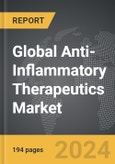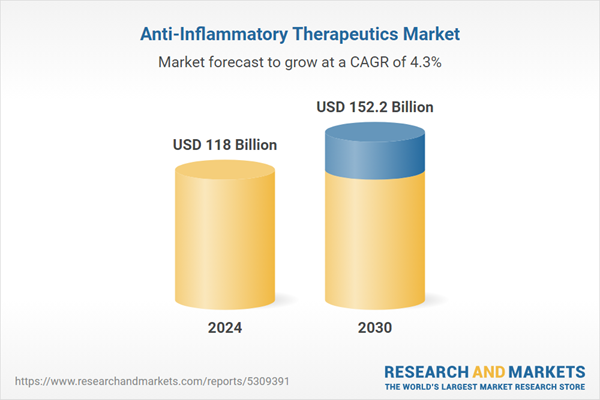The global market for Anti-Inflammatory Therapeutics was valued at US$118.0 Billion in 2024 and is projected to reach US$152.2 Billion by 2030, growing at a CAGR of 4.3% from 2024 to 2030. This comprehensive report provides an in-depth analysis of market trends, drivers, and forecasts, helping you make informed business decisions. The report includes the most recent global tariff developments and how they impact the Anti-Inflammatory Therapeutics market.
Segments: Drug Class (Anti-Inflammatory Biologics, Non-Steroidal Anti-Inflammatory Drugs (NSAIDs), Corticosteroids); Indication (Arthritis, Respiratory Diseases, Multiple Sclerosis, Psoriasis, Inflammatory Bowel Diseases, Other Indications).
Geographic Regions/Countries: World; United States; Canada; Japan; China; Europe (France; Germany; Italy; United Kingdom; Spain; Russia; and Rest of Europe); Asia-Pacific (Australia; India; South Korea; and Rest of Asia-Pacific); Latin America (Argentina; Brazil; Mexico; and Rest of Latin America); Middle East (Iran; Israel; Saudi Arabia; United Arab Emirates; and Rest of Middle East); and Africa.
The analysts continuously track trade developments worldwide, drawing insights from leading global economists and over 200 industry and policy institutions, including think tanks, trade organizations, and national economic advisory bodies. This intelligence is integrated into forecasting models to provide timely, data-driven analysis of emerging risks and opportunities.
Global Anti-Inflammatory Therapeutics Market - Key Trends and Drivers Summarized
How Essential Are Anti-Inflammatory Therapeutics in Modern Healthcare?
Anti-inflammatory therapeutics are integral to modern healthcare due to their pivotal role in managing and alleviating inflammation, a key factor in numerous chronic and acute conditions. Inflammation, a natural defense mechanism, becomes problematic when chronic, contributing to diseases such as rheumatoid arthritis, inflammatory bowel disease, and cardiovascular disorders. Anti-inflammatory drugs, including non-steroidal anti-inflammatory drugs (NSAIDs), corticosteroids, and biologics, are essential for reducing inflammation and pain, thereby significantly enhancing patient quality of life. These medications are widely used across various medical fields, highlighting their critical importance in both acute care and long-term disease management.What Technological Innovations Are Advancing Anti-Inflammatory Drug Development?
Technological innovations are revolutionizing the development of anti-inflammatory drugs, leading to more precise and effective treatments. Breakthroughs in biotechnology and molecular biology have paved the way for biologic therapies that specifically target inflammatory pathways. Biologics, such as monoclonal antibodies and cytokine inhibitors, offer targeted treatment by selectively modulating the immune system, providing a significant advantage over traditional drugs. Advances in genomics and proteomics are identifying new therapeutic targets, facilitating the creation of next-generation anti-inflammatory agents. Additionally, improvements in drug delivery technologies, including sustained-release formulations and targeted delivery systems, are enhancing the efficacy and safety of these therapies, minimizing side effects and boosting patient adherence.Why Is Demand for Anti-Inflammatory Therapeutics Increasing Across Health Conditions?
The demand for anti-inflammatory therapeutics is surging due to the rising incidence of chronic inflammatory diseases and the growing recognition of inflammation's role in numerous health conditions. Chronic conditions like arthritis, asthma, and inflammatory bowel disease impact millions globally, driving a substantial need for effective anti-inflammatory treatments. Furthermore, the aging population is more prone to chronic inflammatory ailments, increasing the demand for these therapeutics. Acute inflammatory responses, resulting from surgeries, injuries, and infections, also necessitate effective management, underscoring the wide-ranging applicability of anti-inflammatory drugs. Additionally, expanding research into the connection between inflammation and diseases such as cancer and neurodegenerative disorders is fostering the development of novel therapies, broadening their application and market potential.What Factors Are Propelling Growth in the Anti-Inflammatory Therapeutics Market?
The growth in the anti-inflammatory therapeutics market is driven by several key factors, including technological advancements, the rising prevalence of inflammatory diseases, and evolving treatment paradigms. Innovations in biotechnology and personalized medicine are leading to the creation of more targeted and effective biologic therapies, which are increasingly preferred for their precision and reduced side effects. The growing incidence of chronic inflammatory conditions, such as arthritis and inflammatory bowel disease, is a significant driver, particularly among the aging population. Additionally, increasing healthcare expenditure and improved access to medical services are enabling more patients to receive treatment for inflammatory conditions. Enhanced awareness of inflammation's role in various diseases is fueling research and development, resulting in innovative therapies that address unmet medical needs. Furthermore, strategic collaborations and partnerships within the pharmaceutical industry are accelerating the development and commercialization of new anti-inflammatory drugs, contributing to a vibrant and expanding market landscape.Report Scope
The report analyzes the Anti-Inflammatory Therapeutics market, presented in terms of units. The analysis covers the key segments and geographic regions outlined below.Segments: Drug Class (Anti-Inflammatory Biologics, Non-Steroidal Anti-Inflammatory Drugs (NSAIDs), Corticosteroids); Indication (Arthritis, Respiratory Diseases, Multiple Sclerosis, Psoriasis, Inflammatory Bowel Diseases, Other Indications).
Geographic Regions/Countries: World; United States; Canada; Japan; China; Europe (France; Germany; Italy; United Kingdom; Spain; Russia; and Rest of Europe); Asia-Pacific (Australia; India; South Korea; and Rest of Asia-Pacific); Latin America (Argentina; Brazil; Mexico; and Rest of Latin America); Middle East (Iran; Israel; Saudi Arabia; United Arab Emirates; and Rest of Middle East); and Africa.
Key Insights:
- Market Growth: Understand the significant growth trajectory of the Anti-Inflammatory Biologics segment, which is expected to reach US$67.7 Billion by 2030 with a CAGR of a 4.4%. The Non-Steroidal Anti-Inflammatory Drugs (NSAIDs) segment is also set to grow at 4.6% CAGR over the analysis period.
- Regional Analysis: Gain insights into the U.S. market, valued at $31.0 Billion in 2024, and China, forecasted to grow at an impressive 6.6% CAGR to reach $32.6 Billion by 2030. Discover growth trends in other key regions, including Japan, Canada, Germany, and the Asia-Pacific.
Why You Should Buy This Report:
- Detailed Market Analysis: Access a thorough analysis of the Global Anti-Inflammatory Therapeutics Market, covering all major geographic regions and market segments.
- Competitive Insights: Get an overview of the competitive landscape, including the market presence of major players across different geographies.
- Future Trends and Drivers: Understand the key trends and drivers shaping the future of the Global Anti-Inflammatory Therapeutics Market.
- Actionable Insights: Benefit from actionable insights that can help you identify new revenue opportunities and make strategic business decisions.
Key Questions Answered:
- How is the Global Anti-Inflammatory Therapeutics Market expected to evolve by 2030?
- What are the main drivers and restraints affecting the market?
- Which market segments will grow the most over the forecast period?
- How will market shares for different regions and segments change by 2030?
- Who are the leading players in the market, and what are their prospects?
Report Features:
- Comprehensive Market Data: Independent analysis of annual sales and market forecasts in US$ Million from 2024 to 2030.
- In-Depth Regional Analysis: Detailed insights into key markets, including the U.S., China, Japan, Canada, Europe, Asia-Pacific, Latin America, Middle East, and Africa.
- Company Profiles: Coverage of players such as AbbVie, Inc., Amgen, Inc., AstraZeneca PLC, Eli Lilly and Company, F. Hoffmann-La Roche AG and more.
- Complimentary Updates: Receive free report updates for one year to keep you informed of the latest market developments.
Some of the 42 companies featured in this Anti-Inflammatory Therapeutics market report include:
- AbbVie, Inc.
- Amgen, Inc.
- AstraZeneca PLC
- Eli Lilly and Company
- F. Hoffmann-La Roche AG
- GlaxoSmithKline PLC
- Johnson & Johnson
- Merck & Co., Inc.
- Novartis AG
- Pfizer, Inc.
Tariff Impact Analysis: Key Insights for 2025
Global tariff negotiations across 180+ countries are reshaping supply chains, costs, and competitiveness. This report reflects the latest developments as of April 2025 and incorporates forward-looking insights into the market outlook.The analysts continuously track trade developments worldwide, drawing insights from leading global economists and over 200 industry and policy institutions, including think tanks, trade organizations, and national economic advisory bodies. This intelligence is integrated into forecasting models to provide timely, data-driven analysis of emerging risks and opportunities.
What’s Included in This Edition:
- Tariff-adjusted market forecasts by region and segment
- Analysis of cost and supply chain implications by sourcing and trade exposure
- Strategic insights into geographic shifts
Buyers receive a free July 2025 update with:
- Finalized tariff impacts and new trade agreement effects
- Updated projections reflecting global sourcing and cost shifts
- Expanded country-specific coverage across the industry
Table of Contents
I. METHODOLOGYII. EXECUTIVE SUMMARY2. FOCUS ON SELECT PLAYERSIII. MARKET ANALYSISCANADAITALYSPAINRUSSIAREST OF EUROPESOUTH KOREAREST OF ASIA-PACIFICARGENTINABRAZILMEXICOREST OF LATIN AMERICAIRANISRAELSAUDI ARABIAUNITED ARAB EMIRATESREST OF MIDDLE EASTIV. COMPETITION
1. MARKET OVERVIEW
3. MARKET TRENDS & DRIVERS
4. GLOBAL MARKET PERSPECTIVE
UNITED STATES
JAPAN
CHINA
EUROPE
FRANCE
GERMANY
UNITED KINGDOM
ASIA-PACIFIC
AUSTRALIA
INDIA
LATIN AMERICA
MIDDLE EAST
AFRICA
Companies Mentioned (Partial List)
A selection of companies mentioned in this report includes, but is not limited to:
- AbbVie, Inc.
- Amgen, Inc.
- AstraZeneca PLC
- Eli Lilly and Company
- F. Hoffmann-La Roche AG
- GlaxoSmithKline PLC
- Johnson & Johnson
- Merck & Co., Inc.
- Novartis AG
- Pfizer, Inc.
Table Information
| Report Attribute | Details |
|---|---|
| No. of Pages | 194 |
| Published | April 2025 |
| Forecast Period | 2024 - 2030 |
| Estimated Market Value ( USD | $ 118 Billion |
| Forecasted Market Value ( USD | $ 152.2 Billion |
| Compound Annual Growth Rate | 4.3% |
| Regions Covered | Global |









